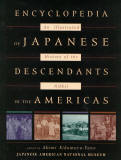
Encyclopedia of Japanese Descendants in the Americas
An Illustrated History of the Nikkei
Edited by Akemi Kikumura-Yano2002, 322 pages, hardback.

 |
Encyclopedia of Japanese Descendants in the Americas
Edited by Akemi Kikumura-Yano |
ORDER -- Item #3046, Price $49.95
The Encyclopedia originated as a collaboration between the International Nikkei Research Project and a multinational team of fourteen institutions, with scholars from ten different countries. It is an impressive reference work for understanding the historical events, special circumstances, and individual and collective choices that shaped communities and the diversity of Nikkei experiences in the Americas. It will be a valuable resource and a fascinating, multifaceted portrait of Japanese immigrants for many audiences: researchers of Japanese immigration, students of ethnic and Asian studies, as well as all people of Japanese and Asian descent. The foreword is by U.S. Senator Daniel K. Inouye.
My own family's immigration history to Hawai'i began soon after as emigrants left in increasing numbers, mainly from prefectures along Japan's Inland Sea. My grandfather was a part of this migration as he set out from his Fukuoka village in Kyushu to work in the cane fields of Hawai'i. In the following decades, the Issei embarked for North, Central and South America, established families and communities, and contributed to the development of the nations where they settled.
This encyclopedia is an important contribution to the study of the Nikkei, the descendants of the Japanese, who settled in the various countries of the Americas. Nikkei in their respective countries who wrote about their own history and experiences developed each of the chapters in this volume. The compilation of their histories into one volume allows for a reexamination of the meaning of community and the process of identity formation among those who consider themselves Nikkei.
Today, globalization is becoming increasingly a common parlance. The seeds of this process were sown some years ago but in recent times, changes have amplified its complexity and have placed the individual histories of Nikkei communities into a broader context. This encyclopedia of Nikkei in the Americas allows for comparisons and thereby increases our own understanding of the process of becoming functional citizens in each of our countries. Furthermore, the forces of globalization have established new relationships between the Nikkei communities, their home nations, and Japan, as a large number of Nikkei Latin Americans have sojourned to Japan and have established Nikkei communities in the land of their ancestors.
It is important to examine the interdependency and interconnections among people in our high tech universe. Our shared knowledge of experiences help to bridge the understanding across nations, cultures, and generations. We need to promote cross-cultural understanding if we are to achieve the best possible world for all in the future.
I commend the Japanese American National Museum and The Nippon Foundation for making this encyclopedia of the Nikkei in the Americas available to the general public through this important publication. This is the first work of its kind that provides an overview of the Nikkei communities in North, Central, and South America. I hope that this volume is just the beginning of comparative studies of the Nikkei in the world. Further documentation and analyses will provide the coming Nikkei generations with the wherewithal to make informed, rational life choices for themselves in the future.
Daniel K. Inouye, U.S. Senator
Book Description from Back Cover
The Encyclopedia is the first comprehensive guide to the history of Japanese immigrants in the Western Hemisphere. Who are the Nikkei and why did they leave Japan over the past two centuries? The Nikkei (people of Japanese descent and their descendants) are described from early immigration to the present as they settled in the countries of Argentina, Bolivia, Brazil, Canada, Chile, Mexico, Paraguay, Peru, and the United States. Each chapter provides four primary areas of information: a historical overview, a bibliographic essay, an annotated bibliography, and supplementary materials such as demographic data and a selection of historical photographs. Contributing authors address common themes of work and recreation, family and community life. Noted scholars Gary Y. Okihiro and Eiichiro Azuma provide key introductory essays on the historical context of Japanese migration from 1868 to the present.
Forward
THERE WERE PROFOUND CHANGES DURING THE LATTER half of the 19th century as the forces of modernization spread throughout the world. Reacting to the impact of the industrial nations of the West, Japan quickly moved out of the era of feudalism. The push and pull of economic forces led to the emigration of Japanese seeking new opportunities in the Americas. Hawai'i, operating within a context of an international market economy, sent officials to actively recruit Japanese for the sugar plantations. In 1868, the first year of Japan's Meiji era, an unauthorized group of laborers, known as the gannen-mono, initiated the overseas migration.
Background on Dr. Akemi Kikumura-Yano
Dr. Akemi Kikumura-Yano is vice president for programs and director of the International Nikkei Research Project at the Japanese American National Museum where she has curated exhibits. She is the author of several books, including Through Harsh Winters: The Life of a Japanese Immigrant Woman and Promises Kept: The Life of a Japanese Immigrant Man.
About |
Contact |
New |
Specials |
Browsing |
Ordering |
Conference |
Links |
Help
Copyright © 2003 by AACP, Inc.
Most recent revision January 3, 2003